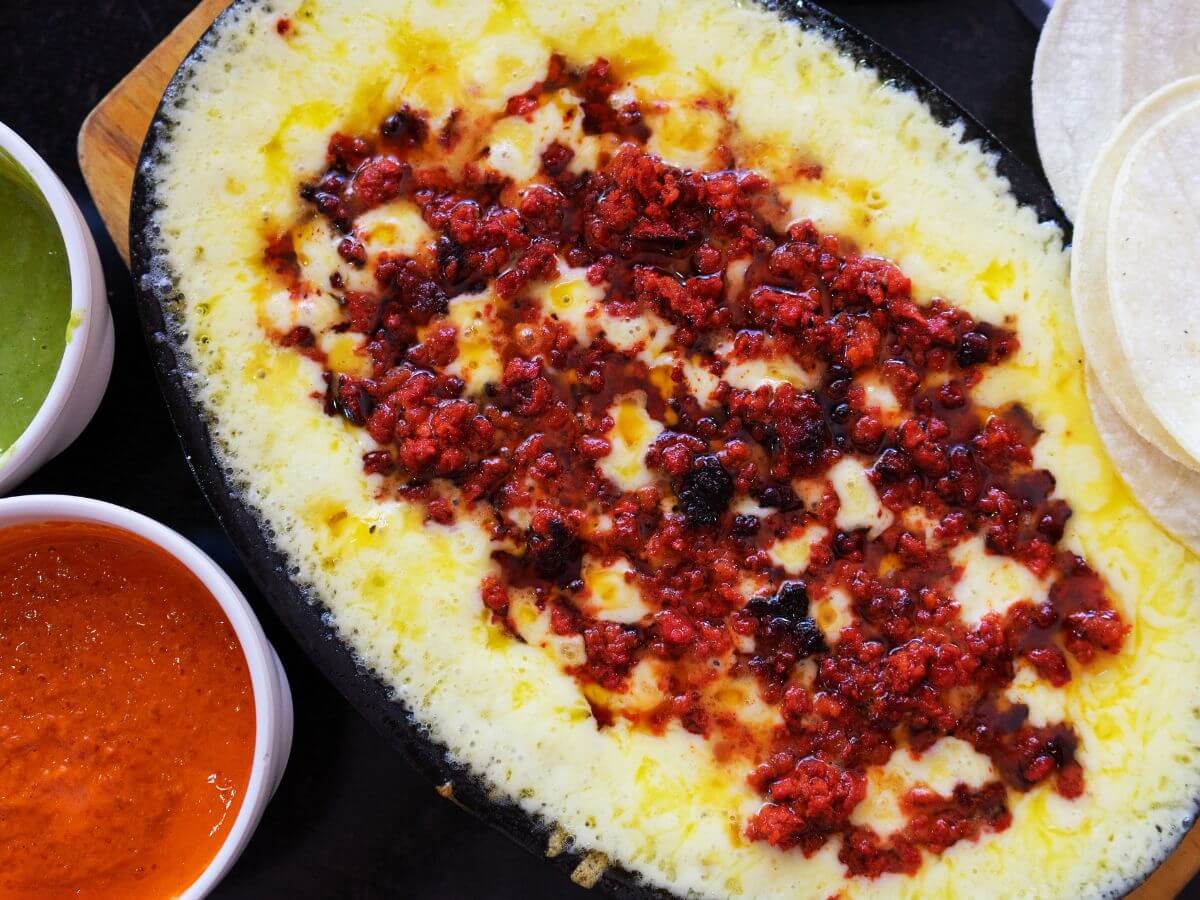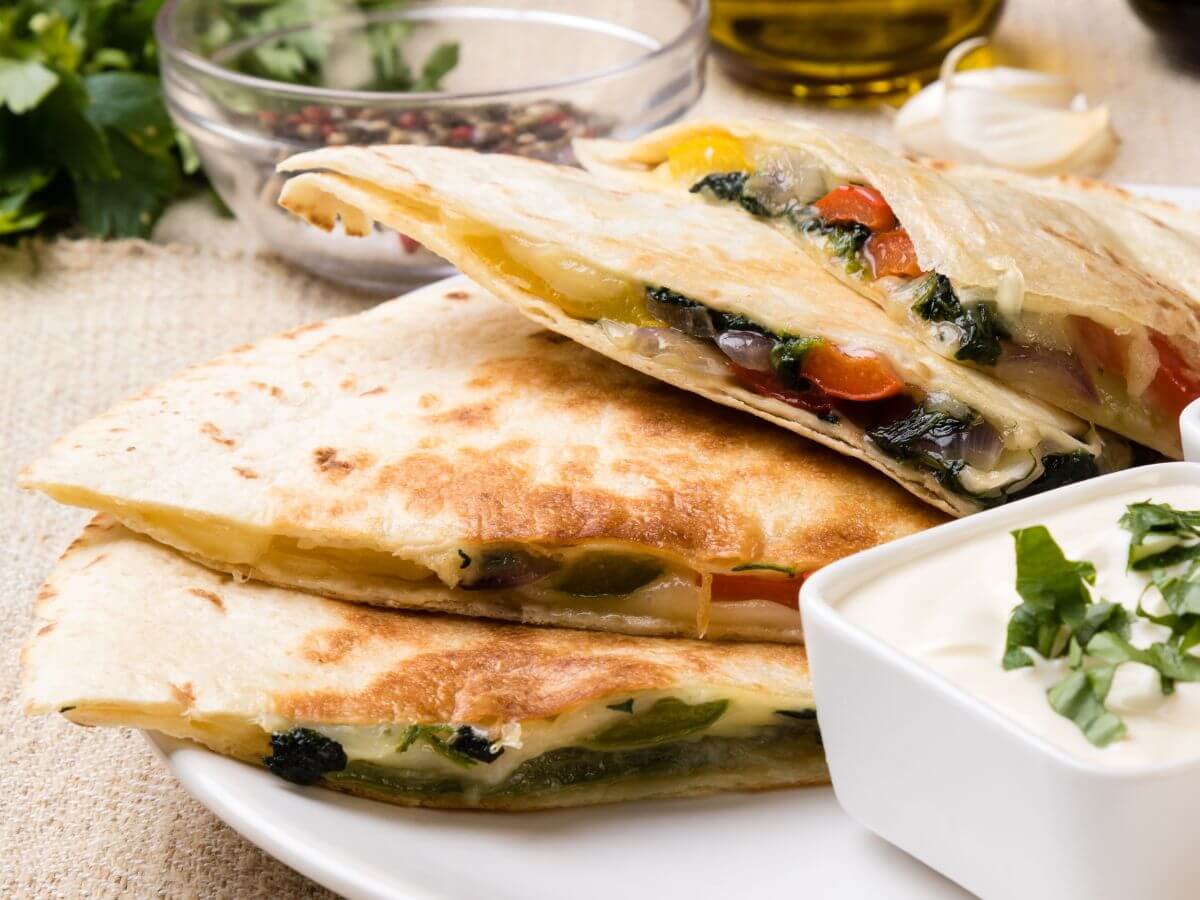The Melty, Tangy Goodness: Exploring the World of Mexican Quesadilla Cheese
Contents
- 1 The Melty, Tangy Goodness: Exploring the World of Mexican Quesadilla Cheese
- 2 What is Quesadilla Cheese?
- 3 How is Quesadilla Cheese Made?
- 4 Popular Dishes that Use Quesadilla Cheese
- 5 Where to Find Authentic Quesadilla Cheese
- 6 Fun Facts about Quesadilla Cheese
- 7 Conclusion: Discovering the Richness of Quesadilla Cheese
The Cheesy History of Quesadilla Cheese in Mexican Cuisine
When it comes to Mexican cuisine, cheese is a staple ingredient that can be found in many traditional dishes. One such cheese that has been used in Mexico for centuries is quesadilla cheese. This semi-soft, mild white cheese is a favorite among locals and tourists alike and is a common ingredient in many classic Mexican dishes.
The history of quesadilla cheese can be traced back to the Aztecs, who were known for making various types of cheeses from cow’s milk, goat’s milk, and sheep’s milk. They used these cheeses as a source of protein and as a means to preserve milk during times when it was abundant.
Quesadilla cheese was one such cheese that they made by coagulating the milk with lime juice or vinegar. Today, quesadilla cheese remains an important part of Mexican cuisine and is used in many popular dishes such as enchiladas suizas, chiles rellenos, tamales, and of course, quesadillas.
Its mild flavor pairs well with spicy ingredients like chili peppers and enhances the overall taste of these dishes. In fact, some would argue that no true Mexican dish is complete without at least a little bit of delicious quesadilla cheese added to it!
What is Quesadilla Cheese?
If you’re a cheese lover, then you’ll definitely appreciate the unique taste and texture of quesadilla cheese. This semi-soft, white cheese is a staple in Mexican cuisine and is commonly used to make the popular dish – quesadillas!
Describing the texture of quesadilla cheese can be a bit challenging because it’s not quite like any other type of cheese. The closest comparison would be to mozzarella, but even that doesn’t do it justice.
The texture of quesadilla cheese is firm yet slightly springy, making it easy to slice and shred. And because it’s a melting cheese, it gets beautifully gooey when heated up.
Description of the Cheese’s Flavor and Appearance
Quesadilla cheese has a mild flavor that’s slightly tangy but mostly salty. It doesn’t overpower other flavors in dishes but adds richness to them with its creamy mouthfeel. The aroma is also quite pleasant in both its fresh and aged forms.
In terms of appearance, quesadilla cheese is usually sold in circular discs or blocks that are about six inches in diameter and two inches thick. The exterior has a smooth surface with no rind or wax coatings like some other types of cheeses have.
Comparison to Other Mexican Cheeses
While there are many Mexican cheeses out there, quesadilla cheese stands out for its unique characteristics. Oaxaca and Chihuahua cheeses are also popular choices for melted dishes like enchiladas or queso fundido, but they have distinct differences from quesadilla as well. Oaxaca cheese has similar springy texture as quesadilla, however Oaxaca has a more delicate flavor profile without the saltiness found in quesadilla – which may make it taste bland when eaten on its own.

Chihuahua cheese, on the other hand, is a firmer cheese with a nutty flavor profile. It’s great for grating over dishes or eating on its own like a cheddar.
Quesadilla cheese is distinctively tasty and versatile among Mexican cheeses. Its mild taste, unique texture and melting properties make it an iconic ingredient in many Mexican recipes.
How is Quesadilla Cheese Made?
Quesadilla cheese is a semi-soft, white cheese that is traditionally made from cow’s milk. The cheesemaking process can vary depending on the region of Mexico and the individual cheesemaker.
However, there are some general steps that are followed in creating this delicious cheese. First, milk is heated and acidified with a combination of rennet and bacteria.
The rennet helps to coagulate the milk solids while the bacteria help to develop flavor and texture. Next, the curds are cut into small pieces and then allowed to rest in their own whey for several hours.
During this time, the acidity of the whey helps to further develop flavor. After resting, the curds are drained and then pressed into molds or shaped by hand.
Many traditional producers will use woven baskets lined with cheesecloth to shape their quesadilla cheese. The cheese is salted and left to mature for several days or weeks before being ready for consumption.
Traditional Methods vs Modern Techniques
While many cheesemakers still use traditional methods for producing quesadilla cheese, there are also modern techniques that have been developed over time. Some producers may use pasteurized milk instead of raw milk, which can help prevent contamination but may also affect flavor. Others may use different types of cultures or starter bacteria to create unique flavors or textures.
Another modern technique that has been adopted by some producers is vacuum-sealing their cheeses during maturation. This can help prevent mold growth and ensure consistent flavor throughout each batch of cheese.
Despite these innovations in technology, many traditional producers remain committed to using raw milk and ancient techniques passed down through generations of cheesemakers. These methods involve great skill and attention to detail but result in cheeses with unparalleled complexity and depth of flavor.
Popular Dishes that Use Quesadilla Cheese
Quesadillas (obviously!)

Quesadillas are perhaps the most well-known dish that uses quesadilla cheese. Traditionally made with two tortillas filled with melted cheese and sometimes other ingredients like cooked meats or vegetables, quesadillas can be found throughout Mexico.
Some regions even have their own unique variations. For example, in the state of Oaxaca, quesadillas are often made with a stringy cheese called “quesillo,” which is similar to quesadilla cheese but has a slightly different texture.
Chiles Rellenos
Chiles rellenos are another popular Mexican dish that often features quesadilla cheese. The dish consists of large chili peppers stuffed with a mixture of meat and vegetables, then coated in egg batter and fried until crispy.
The peppers are usually topped with a tomato-based sauce and served with rice and beans on the side. In some recipes, a small amount of grated or crumbled quesadilla cheese is added to the filling mixture to give it extra flavor.
Enchiladas Suizas
Enchiladas suizas are a type of enchilada that originated in Mexico City. The name means “Swiss-style enchiladas,” although there’s no real connection to Switzerland – it’s just said to refer to the creamy white sauce that tops the enchiladas.
To make them, tortillas are filled with shredded chicken or pork, then rolled up and covered in a creamy salsa verde made from tomatillos and green chilies. Before baking, grated or sliced quesadilla cheese is sprinkled over the top to melt and create a gooey crust.
Tamales
Tamales are another classic Mexican dish that often includes quesadilla cheese. These steamed corn husk-wrapped bundles are typically filled with a savory mixture of meat or vegetables and masa, a dough made from ground corn. Quesadilla cheese can be added to the filling for extra creaminess and flavor, or it can be sprinkled on top after the tamales are cooked.
Molletes

Molletes are a simple and satisfying Mexican breakfast or snack that consists of toasted bread topped with refried beans, melted cheese, and sometimes other toppings like salsa or avocado slices. Quesadilla cheese is often used because it melts beautifully and has a mild flavor that pairs well with the other ingredients. In some regions, molletes are served as an open-faced sandwich with the cheese melted over one half of the bread.
Where to Find Authentic Quesadilla Cheese
Local markets and specialty stores in Mexico
If you want to experience authentic Mexican quesadilla cheese, there’s no better place to look than local markets and specialty stores in Mexico. These shops often carry a wide variety of Mexican cheeses, including quesadilla cheese, straight from local producers. You can choose from different brands and varieties of the cheese, depending on your taste preferences.
One great place to start is at a local mercado (market), where you’ll find vendors selling everything from fresh produce to handmade crafts. Look for stalls that specialize in dairy products or that have signs advertising queso fresco or queso de bola (ball-shaped cheese).
These vendors are likely to have quesadilla cheese among their selection. Don’t be afraid to ask questions or sample the different varieties before making your purchase.
Online retailers that specialize in Mexican cheeses
If you don’t have access to local markets in Mexico or just want the convenience of shopping from home, there are several online retailers that specialize in Mexican cheeses. These retailers usually offer a wider variety of cheeses than what you might find at your local grocery store, including hard-to-find varieties like quesadilla cheese.
One popular online retailer is MexGrocer.com, which offers a variety of authentic Mexican products including food items and household goods. Their selection of Mexican cheeses includes popular brands like El Mexicano and La Vaquita as well as artisanal options from smaller producers.
Another option is Mi Rancho Tortillas, which specializes in tortillas but also carries a selection of authentic Mexican cheeses including queso fresco and Oaxaca cheese. Their website also includes recipes featuring their products so you can get some inspiration for how to use your quesadilla cheese once it arrives.
No matter where you decide to buy your authentic Mexican quesadilla cheese, be sure to do your research and choose a reputable seller. This will ensure that you get high-quality cheese that is both delicious and safe to eat.
Fun Facts about Quesadilla Cheese
The word “queso” means cheese in Spanish, so “queso quesadilla” technically means “cheese cheese sandwich”
One of the most interesting things about quesadilla cheese is its name. The word “quesadilla” comes from the Spanish word “queso,” which simply means cheese. Therefore, when you order a quesadilla in Mexico, you’re essentially ordering a cheese sandwich.
This is because the traditional Mexican dish consists of a tortilla filled with melted cheese, folded in half and often grilled until crispy on both sides. While some may think that the name is redundant or unnecessary, it actually makes perfect sense when considering that there are many other types of quesadillas besides those filled with just cheese.
In fact, there are numerous variations that can include ingredients like meat, vegetables, and even fruit! However, no matter what kind of filling is used, the name remains the same: queso (cheese) + tortilla = quesadilla.
In some regions of Mexico, quesadillas are made with blue corn tortillas instead of the traditional white corn tortillas
Another fun fact about quesadillas is that they’re not always made with white corn tortillas. In certain regions of Mexico – particularly Oaxaca – it’s common to use blue corn tortillas instead.
These have a slightly nutty flavor and distinctive blue hue that adds a unique twist to this classic dish. The reason behind this variation stems from tradition and availability.
Blue corn was once more widely available than white in certain areas of Mexico due to its resistance to pests and disease. As such, it became a staple food source for many indigenous communities who would use it to make everything from tamales to tortillas.
So if you ever find yourself visiting Oaxaca or another region of Mexico where blue corn tortillas are common, be sure to try a quesadilla made with them. Who knows – you may just discover a new favorite version of this beloved dish!
Conclusion: Discovering the Richness of Quesadilla Cheese
Quesadilla cheese is a cultural icon in Mexican cuisine. With its unique texture, flavor and versatility, it has become a staple in many traditional dishes.
While it may be tempting to substitute this delicious cheese for other similar types such as Monterey Jack or mozzarella, true quesadilla enthusiasts know that there is simply no replacement for the real thing. Making quesadilla cheese is not an easy task.
It involves a delicate balance of heat and humidity to achieve that perfect stretchy consistency while still maintaining its rich flavor profile. However, with access to local markets or online retailers specializing in Mexican cheeses, you too can experience the authentic taste of this beloved ingredient.
Whether you enjoy your quesadillas filled with juicy meats or fresh veggies, smothered in sauce or served plain with a side of guacamole and salsa, there are countless ways to enjoy the magic of quesadilla cheese. So next time you’re cooking up some Mexican-inspired dishes at home or dining out at your favorite taqueria, make sure to savor every bite of this delectable ingredient that has captured the hearts and tastebuds of foodies worldwide.
